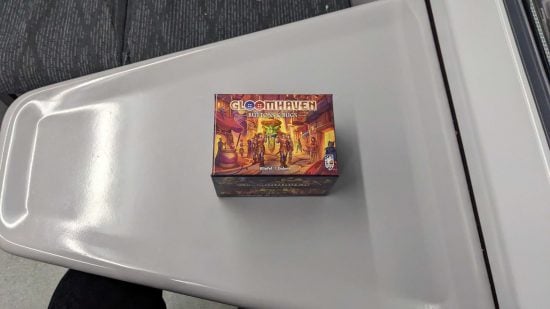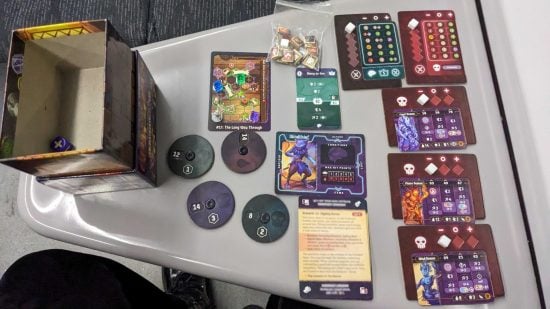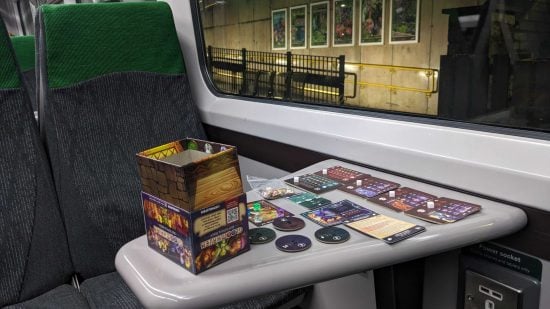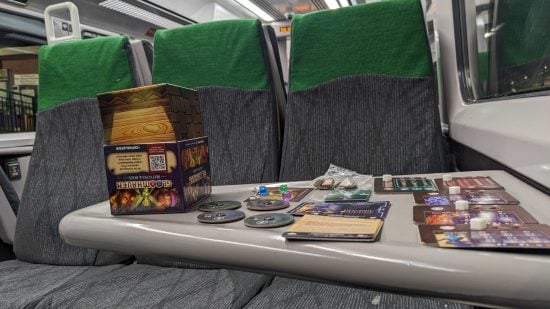A train is arguably one of the worst places to play a board game. The tables are tiny, the seating is cramped, and there’s a chance a stranger could sit down next to you at any moment. Shuddering walls and regular stops add a new challenge to moving miniatures and rolling dice. But Gloomhaven: Buttons & Bugs promised to be a great one-player travel game, so I had to test it out for myself.
Before hopping on the next train out of town, I also caught up with the game’s co-designer, Nikki Valens. They took me on a whistle-stop tour of Buttons & Bugs, explaining how the original, enormous Gloomhaven was translated into such a teensy tabletop game. And no, it wasn’t a shrink ray.
Picture the scene: me, a humble Wargamer, setting up a micro board game as the 18:38 train pulls out of Bath. My chosen table is an awkward pyramid shape, and I’m terrified of losing the game’s single purple die. This means I have to get creative with the layout of my components, and I cunningly repurpose the game box as a dice tray.

Like the original Gloomhaven, Buttons & Bugs is a dungeon crawler, where you race to complete a scenario before your character becomes exhausted – either by taking too much damage or by running out of action cards to play. Unlike big brother Gloomhaven, Buttons & Bugs’ dungeons are limited to a single room, traversed by a single character. Each dungeon is printed on the back of a story synopsis that also doubles up as items you can loot after a successful crawl.
Nikki Valens tells me the design of these shrunken dungeons was “a challenge because there’s only so much you can do with a single room”. Two key design choices kept things from getting repetitive. The first of these was a new approach to hazardous terrain.
“I kept wanting to use traps in the game, but we didn’t have a way to mark them”, Valens tells Wargamer. “We were trying to remove memory issues from the game, where you just had to remember if things had been triggered or not. And I realized we can still do interesting hazardous terrain without it being something you had to remember.”
“In Gloomhaven, hazardous terrain is just damage and nothing else”, they explain. For Buttons & Bugs, Valens and their co-designer (Gloomholdin’s Joe Klipfel) merged traps and terrain. “We basically turned it into traps that don’t go away, with lower damage but effects like poison or stun”, Valens says. “Those really helped to make the environment feel a little bit more alive.”
Clever monsters also add variety to a dungeon. In Buttons & Bugs, each foe is represented by a tiny colored cube, with a single card to represent them. This is slotted into a tiny double-punched board, with indents for another white cube. At the start of a round, you roll the die to determine which of the three slots this cube goes in – and which initiative number and move set the monster uses that turn.
“We were able to make the enemies interact with each other a bit more”, Valens says. “You really see this once you hit the first boss battle in the game and the enemies start to use elements.” Elements, which fuel special abilities for players and monsters, are now spread across action cards and enemy cards – if you can see an element, it can be consumed for an ability once per round, as long as you use it up before your foe.
As my train speeds to its first stop, I’m grateful for the indents in the monster boards. These keep some of my cubes firmly in place – one less thing to worry about. Gloomhaven’s signature damage modifier decks have also been replaced with a double-punch board and a white cube that fills a hole. When you or a monster attacks, you roll the die to determine your modifier, moving the white cube down to the next hole after every attack.
While modifiers and monsters are well protected, I’m very concerned about the components in each dungeon. The enemy cubes, condition tokens, and my adorable little character mini are free to slide around, vulnerable to a sudden jolt or a clumsy hand.
I’m particularly attached to my miniature, which is an adorable, fingernail-sized version of the same character from the original game. Valens tells me these were inspired by clamshell toys like Mighty Max and Polly Pocket – and yes, there is a risk of losing them.
“That’s the problem with micro games like this”, they say. “It’s why, where possible, we tried to use slotted components to keep things more secure.” “We also used dials for tracking health points”, they add. “But there are still some small components, so I would imagine there will be people accidentally losing these minis, unfortunately.”
Just as the monsters, minis, and maps have been made minuscule, so too have the player cards. Each of the Gloomhaven classes has been condensed, with only four double-sided cards to choose from during a scenario. Once you’ve played side A, you flip to side B, discarding when the B side has been used. Resting works the same as in the original game, so you’ll lose a card for good every time you’ve less than two cards in hand to play.
The results? Buttons & Bugs dungeons are 30-minute affairs, and you’ll need to play efficiently to beat a scenario. With an hour-long journey ahead of me, I’ve plenty of time on my train trip to mull over the optimum plays – as well as how differently the button-sized characters play.
Not every class needed an overhaul for Gloomhaven’s downsize. Valens says the Bruiser plays much the same, and the Spellweaver still has some of its signature abilities, but “others had to have various redesigns”.
For example, the Cragheart gains more combat bonuses in lieu of placing obstacles, and the Mindthief’s summons are replaced with Shield and Retaliate. The Scoundrel (now called the Silent Knife) can’t use its flanking abilities in a solo board game, so it has new bonuses for going invisible to recreate the feeling of a sneak attack. Similarly, the Tinkerer has ways of recycling lost cards instead of starting with more cards than its peers.
“I think [Buttons & Bugs] does a good job of including all the core systems of Gloomhaven”, Valens tells Wargamer. “The top-and-bottom action cards, how enemies work – all those things are there to be a gateway into the full mechanics of Gloomhaven.”
Simplifications aside, one advantage of the trimmed playtime is that I can pack the whole game up before the train arrives at my stop. It’s refreshing to play a Gloomhaven game where setup and cleanup don’t take as long as the game itself. And as I touch down at my destination, I feel satisfied that Cephalofair has delivered on its promise.
Buttons & Bugs is a functional, fun travel board game. It still feels like Gloomhaven, with some of the fat trimmed. Just keep a close eye on where your components are. And be sure to read the rules before you travel – those still take a good while to get through.
Buttons and Bugs is available for pre-order on Cephalofair’s website. For more on this title, here’s our full Gloomhaven Buttons & Bugs review. You can also see what we think of Cephalofair’s other games in our Gloomhaven review and Frosthaven review. Both big games are also in our guide to the best board games of all time.




